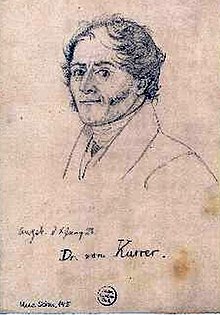Wilhelm Heinrich Jacob von Kurrer
Wilhelm Heinrich Jacob von Kurrer (born June 8, 1782 in Langenbrand (Black Forest) , † December 28, 1862 in Zwickau ) was a chemist , calico printer , textbook author and industrialist .
Live and act
Kurrer, son of a Protestant pastor in Langenbrand and Reutlingen , started training as a merchant in 1798 at the age of 16 in the Bodmer'schen calico factory in Großenhain ( Saxony ). Even during his training as a commercial clerk, he dealt intensively with the chemistry of colors for the printing and dyeing technology of textiles. As early as 1802 he published the knowledge and experience he had gained in a specialist journal that was published by Sigismund Friedrich Hermbstädt .
The early industrial company Schöppler & Hartmann in Augsburg , at that time the largest calico printing dyeing works in Germany, gave Kurrer the position of manager of this manufactory in 1815 , which he held until 1830. Then Kurrer moved to Hungary to the calico factory of the Baron von Puthon zu Sassin . In 1832 he then took over the management of the Porges brothers' calico factory in Prague .
In 1844, Kurrer ended his industrial career and concentrated only on his research and publications, which he had never neglected during his professional life. In 1816 he founded the Polytechnical Journal together with Johann Gottfried Dingler and in 1818, together with Dingler, translated Bancroft's English dye book into German, which was followed in 1824 by Vitali's "Outline of the Art of Dye " . According to Joachim Radkau , textile color printing received new impulses after 1800 from Dingler, Karl Ludwig Forster (1788–1877) and Kurrer and entered the first stage of scientification.
Right up to his old age, Kurrer continued to research his specialty and published a number of books and publications.
As a member of numerous associations and organizations, the University of Landshut awarded him an honorary doctorate in 1823.
Fonts
- The art of vegetabil.-animal. u. pure animal. Bleaching Fabrics, 1831;
- Business d. Stuff printing, d. associated machines u. Auxiliary tools and inventions in the field of d. Colors f. Cotton, linen, silk u. * Sheep wool print, 1840;
- The bleaching d. Canvas ad linen fabrics in d. europ. Countries, vd standpoints d. Knowledge ud practical experiences illuminated, 1850, 21854;
- The printing u. The art of dyeing in its entirety, 3 vols., 1848–50;
- The new process, canvas u. to bleach linen fabrics, as it was introduced at Blaubeuer in the Kgr. Württemberg, 1854;
- About silica compounds (water glass) u. their advantageous use in d. Pressure u. Dyeing, as well as z. Heavy, compacting, finishing etc. of various woven fabrics, 1857;
- The latest od. D. latest discoveries and Inventions in d. Areas d. Pressure u. Dyeing, 1858, 21862. -
- Ed. (With KW Juch): Neues Journal fd Indianen- u. Cotton Printing Works, 4 vols., 1815–17;
- Mgz. f. Pressure u. Dyeing, 3 vols., 1818–20.
Individual evidence
- ↑ a b c d Udo B. Wiesinger: Kurrer, Wilhelm Heinrich von. NDB , accessed on August 6, 2019 .
- ↑ Constantin von Wurzbach : Porges Edle von Portheim, Moses and Leopold (Juda) . In: Biographisches Lexikon des Kaiserthums Oesterreich . 23rd part. Imperial and Royal Court and State Printing Office, Vienna 1872, p. 123 ( digitized version ).
- ^ Joachim Radkau: Technology in Germany. From the 18th century to the present . Frankfurt am Main: Suhrkamp Verlag 1989, pp. 83f, ISBN 3-518-11536-7
- ↑ Constantin von Wurzbach : Kurrer, Wilhelm Heinrich Jacob von . In: Biographisches Lexikon des Kaiserthums Oesterreich . 13th part. Kaiserlich-Königliche Hof- und Staatsdruckerei, Vienna 1865, pp. 419–421 ( digitized version ).
| personal data | |
|---|---|
| SURNAME | Kurrer, Wilhelm Heinrich Jacob von |
| BRIEF DESCRIPTION | German chemist, calico printer, specialist book author and industrialist |
| DATE OF BIRTH | June 8, 1782 |
| PLACE OF BIRTH | Langenbrand (Black Forest) |
| DATE OF DEATH | December 28, 1862 |
| Place of death | Zwickau |
